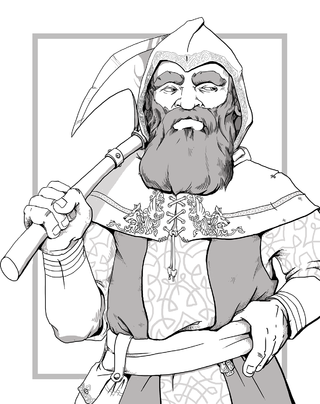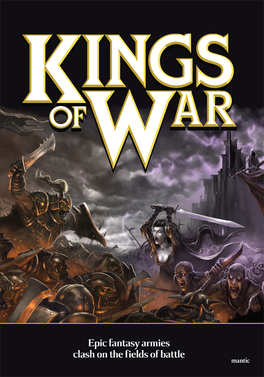Related Research Articles
Blood Bowl is a miniatures board game created by Jervis Johnson for the British games company Games Workshop as a parody of American football. The game was first released in 1986 and has been re-released in new editions since. Blood Bowl is set in an alternate version of the Warhammer Fantasy setting, populated by traditional fantasy elements such as human warriors, goblins, dwarves, elves, orcs and trolls.

Warhammer Fantasy is a fictional fantasy universe created by Games Workshop and used in many of its games, including the table top wargame Warhammer Fantasy Battle, the Warhammer Fantasy Roleplay (WFRP) pen-and-paper role-playing game, and a number of video games: the MMORPG Warhammer Online: Age of Reckoning, the strategy games Total War: Warhammer, Total War: Warhammer II and Total War: Warhammer III and the two first-person shooter games in the Warhammer Vermintide series, Warhammer: End Times - Vermintide and Warhammer: Vermintide 2, among many others.

Warhammer is a tabletop miniature wargame with a medieval fantasy theme. The game was created by Bryan Ansell, Richard Halliwell, and Rick Priestley, and first published by the Games Workshop company in 1983.

Warhammer: Shadow of the Horned Rat is a single-player fantasy real-time tactics computer game based upon the Warhammer Fantasy Battle table-top game and miniatures. It was developed and published by Mindscape, and released in November 1995 for Microsoft Windows, and on PlayStation in November 1996. The game's story takes place within the Warhammer Fantasy world setting, and focuses on players managing a group of mercenaries, who take on work for various clients but become involved in stopping a plot by the Skaven. The game's main focus is on battles that feature a mixture of medieval warfare and fantasy elements, using a variety of units based upon those from within the Warhammer setting.

Fantasy Warlord is a fantasy miniatures game released in 1990 by Folio Works. It was written by Ian Bailey and Gary Chalk who also did the illustrations.
Birthright is a Dungeons & Dragons campaign setting that was first released by TSR in 1995. It is based on the continent of Cerilia on the world of Aebrynis, in which the players take on the role of the divinely-empowered rulers, with emphasis on the political rulership level of gameplay. The setting revolves around the concept of bloodlines: divine power gained by heroes and passed to their descendants. Characters with a bloodline create an aura of command known as Regency, which is measured in the game using regency points or RP. Using regency, characters acquire a domain composed of provinces and holdings. The development of these domains is as much a part of the game as development of the characters. The game uses three-month domain turns to model actions of rulers over nations in much the same way as Dungeons & Dragons uses combat rounds to simulate time to model the characters' actions in battle. In 1996, Birthright won the Origins Award for Best Roleplaying Supplement of 1995.

In many works of modern fantasy, elves are depicted as a race or species of pointy-eared humanoid beings. These depictions arise from the álfar of Norse mythology influencing elves in fantasy as being semi-divine and of human stature, whose key traits are being friendly with nature and animals. However, this differs from Norse and the traditional elves found in Middle Ages folklore and Victorian era literature.

The Lord of the Rings: The Battle for Middle-earth II is a 2006 real-time strategy video game developed and published by Electronic Arts. The second part of the Middle-earth strategy game series, it is based on the fantasy novels The Lord of the Rings and The Hobbit by J. R. R. Tolkien and its live-action film series adaptation. It is the sequel to Electronic Arts' 2004 title The Lord of the Rings: The Battle for Middle-earth. Along with the standard edition, a Collector's Edition of the game was released, containing bonus material and a documentary about the game's development.

A dwarf, in the Dungeons & Dragons (D&D) fantasy roleplaying game, is a humanoid race, one of the primary races available for player characters. The idea for the D&D dwarf comes from the dwarves of European mythologies and J. R. R. Tolkien's novel The Lord of the Rings (1954-1955), and has been used in D&D and its predecessor Chainmail since the early 1970s. Variations from the standard dwarf archetype of a short and stout demihuman are commonly called subraces, of which there are more than a dozen across many different rule sets and campaign settings.

A fantasy wargame is a wargame that involves a fantastical setting, and employs rules for elements such as magic and non-human intelligent creatures.

The Lord of the Rings: War of the Ring is a 2003 real-time strategy game (RTS) developed by Liquid Entertainment and published by Sierra Entertainment, a subsidiary of Vivendi Universal Games. Set in J. R. R. Tolkien’s fictional Middle-earth, it expands upon the events of the War of the Ring as told in his fantasy novel, The Lord of the Rings.

The elf is a humanoid race in the Dungeons & Dragons fantasy role-playing game, one of the primary races available for player characters, and play a central role in the narratives of many setting worlds of the game. Elves are described as renowned for their grace and mastery of magic and weapons such as the bow and sword. Becoming physically mature by the age of 25 and emotionally mature at around 125, they are also famously long-lived, capable of living more than half a millennium and remaining physically youthful. Possessed of innate beauty and easy gracefulness, they are viewed as both wondrous and haughty by other races in-universe; however, their natural detachment is seen by some as introversion or xenophobia. They were usually portrayed as antagonistic towards dwarves.
Midnight is a campaign setting for the Dungeons & Dragons role-playing game, released under the Open Gaming License. It was published by Fantasy Flight Games from 2003 to 2009.

In the Dungeons & Dragons fantasy role-playing game, the centaur is a large monstrous humanoid. Based upon the centaurs of Greek myth, a centaur in the game resembles a human with the lower body of a horse.
Flintloque is a Historo-Fantasy Skirmish miniatures wargame based on the Napoleonic Wars.
Castlemourn is a campaign setting for the Dungeons & Dragons role-playing game by Ed Greenwood, published by Margaret Weis Productions, Ltd. The world of Castlemourn lost its past during a cataclysm, and now various races try to find their history.

Elven Legacy is a turn-based strategy video game developed by 1C:Ino-Co and published by Paradox Interactive. Released in Russia in 2007 and elsewhere in 2009 for Microsoft Windows, the game is a sequel to Fantasy Wars. On October 11, 2011, Virtual Programming released Elven Legacy Collection, which includes the original game and its three expansion packs, for Mac OS X.

Kings of War, is a tabletop wargame created by Mantic Games.
Demonworld is a tabletop wargame originally created by Hobby Products, a German gaming company. The game went out of production for several years but has recently been purchased and re-released by Ral Partha Europe, as announced on 8 June 2011.

Character race is a descriptor used to describe the various sapient species and beings that make up the setting in modern fantasy and science fiction. In many tabletop role-playing games and video games, players may choose to be one of these creatures when creating their player character (PC) or encounter them as a non-player character (NPC). "People" is to be taken in the broader sense, and may encompass ethnic groups, species, nationality or social groups.
References
- ↑ "Golem Arcana Review". Play Board Games. Retrieved 2024-02-12.
{{cite web}}: CS1 maint: url-status (link)